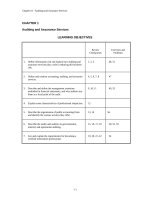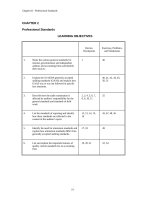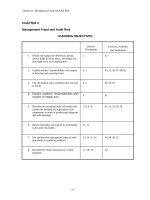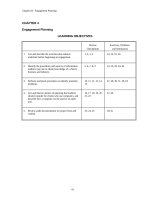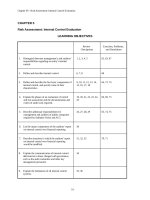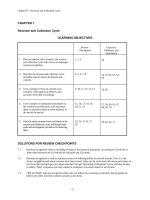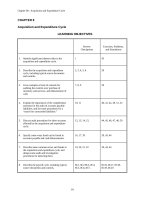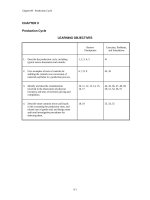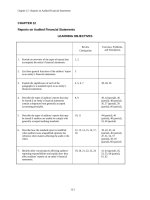Solution manual cost and managerial accounting by barfield 3rd emerging management practices
Bạn đang xem bản rút gọn của tài liệu. Xem và tải ngay bản đầy đủ của tài liệu tại đây (191.83 KB, 22 trang )
Chapter 17
Emerging Management Practices
Questions
1.
Two of the major factors pressuring managers to
develop innovative practices are the advancement of
technology and the globalization of competition. Advancing
technology has increased the quality level of production
processes and allowed more processes to be automated.
Advancing technology has also led to greater integration of
information systems. Globalization of competition has
increased the quality and intensity of competition.
2.
Business process reengineering, BPR, is a method of
examining processes to identify and then eliminate, reduce,
or replace functions and processes that add little customer
value to products or services.
BPR is a tool to achieve radical changes in business
processes. Managers apply BPR to achieve wholesale gains in
cost or quality.
3.
BPR is an effective tool to improve quality. First
managers must identify the sources of quality problems.
Then, BPR can be applied to replace, change, or eliminate
those processes.
4.
Finding ways to better satisfy customers by improving
quality, reducing costs (prices), or increasing
functionality of the product or service is the objective of
applying BPR techniques. A company must understand how the
customer derives value from the product or service and how
the customer assesses quality before it can effectively
reengineer processes.
5.
BPR is a tool that leads to revolutionary changes in
operations. Often these changes leverage technology and
reduce the required labor content of a process or product.
The consequence of reduced demand for labor is reduction of
the workforce.
197
198
Chapter 17
Emerging Management Practices
6.
Downsizing is any management action that reduces
employment and restructures operations as a response to
competitive pressures. To maintain or increase market share
in today’s competitive markets, firms must continually
strive to increase the quality and functionality of products
while reducing costs. These pressures cause firms to
continually evaluate their processes and increase their
dependence on evolving technologies. As the level of
automation increases, efficiency increases and the demand
for labor is reduced. Layoffs are the inevitable result.
7.
The risks include the depletion of future talent
pools, a permanent loss of organizational knowledge, a loss
of trust between management and workers, and destruction of
a corporate culture of cooperation between managers and
workers.
8.
Downsizing is an accounting issue because it is
a financial decision. Costs and benefits of downsizing must
be analyzed like any other long-term decision. Also, there
are financial reporting issues to be examined including the
financial consequences of severance packages, employee
retraining, and the sale of idle assets.
9.
A downsizing decision involves the comparisons of
costs and benefits. The largest benefit derived is the
savings in labor costs that will occur over future periods.
The costs are mostly incurred currently for restructuring
costs. Because costs and benefits do not occur within the
same periods, capital budgeting tools using discounted cash
flow analysis must be used to account for the time value of
money.
10.
The expansion of operations around the globe has
increased the diversity of the workforce of many
firms. Employees of large firms often speak different
languages, and have different cultures, religions, and work
habits.
The accounting systems in global firms face an
increased burden because accounting is often the only
language that is common to all managers and employees and,
therefore, the only language in which communication can
occur freely without an interpreter.
Chapter 17
Emerging Management Practices
199
11.
In the United States, increased diversification has
resulted from both the passage of new laws and the selfserving actions of firms. Federal, state, and local
governments have enacted statutes to pursue affirmative
action programs and outlaw discrimination. However, many
firms now pursue diversification beyond the legal mandates
because managers believe a more diverse workforce offers
advantages in serving a diverse customer base.
12.
ERP systems are packaged software programs that allow
companies to automate data gathering and processing
and integrate information feeder systems to provide useful
real-time information to managers.
ERP systems differ from prior generations of systems in
the extent to which the various feeder systems (e.g.,
payroll, accounts payable) are integrated into a common
database. ERP systems also integrate supply (value) chains
to a much greater extent than previous production management
systems.
13.
ERP systems link the customer to the rest of the supply
chain through, typically, a Web-based front door. The
customer can place an order for a product or service on the
Internet. The processes and inputs necessary to satisfy the
customer order are then coordinated by the ERP software
throughout the supply chain.
14.
ERP systems are built from combining modules. A typical
installation includes 30 or more separate modules. Each
module corresponds to a domain of activity or
accountability. For example, typical modules include order
processing, manufacturing, receiving, and cash collections.
15.
An ERP system is built around a central data bank. Data are
entered into the central repository through modules or
feeder systems. Data from the various feeder systems can
then be linked in the central repository and manipulated to
suit the needs of the information user.
200
Chapter 17
Emerging Management Practices
16.
The finance function is affected in three ways by the
implementation of an ERP system. First, finance and system
specialists bear primary responsibility for selecting and
installing the ERP software. Second, finance specialists
bear responsibility for manipulating and evaluating the
information in the central repository to meet the
information needs of managers. Third, the finance
specialists bear the responsibility of maintaining the
integrity of the data in the central repository from
intentional or incidental contamination.
17.
Data mining is the application of statistical techniques to
data for the purpose of gaining new insights about problems
or opportunities. An ERP system facilitates data mining
because the central repository of information contains a
rich database of all important aspects of operations:
financial, customer, supplier, etc.
18.
Strategic alliances are agreements between firms that
result in their combining competencies and resources to
create products and services for customers.
Strategic alliances are increasingly used today because
they are an effective response to competitive pressures.
Firms have been forced to select core competencies that they
will maintain and defend. If delivery of a product or
service requires core competencies not possessed by a given
firm, that firm must contract with another firm or firms to
provide those competencies. A strategic alliance is a
flexible approach to combining the needed competencies to
deliver high-quality goods and services to customers at
competitive prices.
19.
Strategic alliances can take many forms including joint
ventures, equity investments, licensing, joint R&D
arrangements, technology swaps, and exclusive buyer/seller
agreements.
Chapter 17
Emerging Management Practices
201
20.
One of the first decisions to be made is whether a new
entity will be established to execute the business of the
strategic alliance. If a new entity is established, a
decision as to the type of entity to form is made.
A system of governance must also be established. This
process may involve establishing a separate board of
directors from the managers of the participating firms.
Also, an agreement must be executed to establish the
rights and responsibilities of each participant, including
what each is expected to contribute and what each is
entitled to receive from the strategic alliance.
Finally, strategies, operating plans, and control
systems must be devised so that the objective for which the
strategic alliance was formed is realized.
21.
Open-book management is a philosophy about the use of
information in a business. The central idea of open-book
management is that information should be shared and consumed
by all organizational participants—not just managers.
This view about information contrasts with the more
traditional view in which information is regarded as an
asset that must be safeguarded, and access to it must be
limited to managers who are trained in its use.
22.
The implementation of open-book management changes the roles
of accountants. Accountants must no longer act as guardians
of information but become purveyors of information.
Additionally, accountants must devise ways to help
unsophisticated users of information develop skills and
abilities in consuming financial data. Games are often
devised to aid in this process.
23.
Games can create an incentive to use financial information.
For workers who are unsophisticated in the use of accounting
data, a simplification of the data can be made by the
accounting staff and be presented in the guise of a game.
By tying employee compensation to the outcomes of the game,
an incentive is created for employees to perform well in the
game. As employees strive to compete in the game, they
consume information to improve their performance. Thus, the
game can be used as a device to create demand for
information. As employees observe ways to use the
information to improve their performance, they eventually
observe that information is a tool they can use to achieve
larger rewards.
202
Chapter 17
Emerging Management Practices
24.
Accountants must find ways to simplify accounting
information to bring it within the grasp of less
sophisticated workers. Games are one tool to achieve this
result. Additionally, accountants can devise simplified
accounting systems that capture the most important
dimensions of performance for employee groups. As the
groups master the use of the simplified information systems,
more complete information systems can be substituted.
25.
If managers or employees have not been accustomed to
consuming financial or other data in executing their duties,
an inducement may be necessary to motivate their use of
information. If employees’ rewards are dependent on their
skillful use of information, then an incentive is created
for the employees to become better consumers of information.
26.
Generally, smaller firms will have more success than larger
firms in implementing open-book management because each
employee’s contribution to the bottom line is more
identifiable. Firms with decentralized structures are more
suited to open-book management because they require lower
level managers and employees to make decisions and be
accountable for results. Environments in which there is a
high level of trust between managers and workers will stand
a much better chance of surviving the cultural changes that
must occur to implement open-book practices.
27.
The environmental impact of company operations has become a
major concern of managers for two reasons. First,
legislation has imposed a larger burden on firms to be
accountable for environmental emissions and other
environmental impacts. Second, the capital market has
become sensitive to environmental issues because of the
potentially large costs associated with remediation of
environmental damage.
28.
The first strategy is to clean up environmental contaminants
after they have been produced. The second strategy is to
develop processes to reduce and recycle waste that is
created. The third strategy is to avoid producing
pollutants in the first place.
Economically, none of these strategies will dominate
the others in every circumstance. However, over the long
run, the goal should be to reduce the production of
environmental waste.
Chapter 17
Emerging Management Practices
203
Exercises
29.
a.
Without training the firm will have a smaller
probability of successfully implementing the software.
Additionally, training is necessary to understand the
features and functions of the technology and to
accelerate the generation of benefits of the
implementation.
b.
The financial experts in a business play
important roles in technology acquisitions. Before
technology is acquired, financial experts analyze the
costs and benefits to determine if new technology is
justified. Next, financial experts help screen the
products of competing vendors to identify the product
that meets the firm’s needs at the lowest cost.
Finally, the financial experts manage the process of
implementation to ensure that the product functions as
promised by the vendor and confirm that the costs
incurred and benefits generated are consistent with the
expectations.
30.
The use of higher technology is commonplace in
business today. Further, technology is increasingly a major
component of strategies being planned and executed by firms.
Financial professionals, having responsibility for managing
the process of technology acquisition, must now have a
broader understanding of their businesses. Without fully
understanding competitive strategies and business
operations, financial professionals will be unable to make
the appropriate recommendations about acquiring new
technology and will not be capable of understanding whether
technology is serving as an effective strategic and
operational tool.
31.
There is currently debate in the academic and
practitioner communities as to how TQM and BPR relate
to each other. While some argue that BPR can be viewed as a
tool of TQM, others argue that BPR is a philosophy about
achieving revolutionary changes in operations while TQM is
more about seeking continual, incremental improvements in
operations.
32.
No solution provided.
Chapter 17
Emerging Management Practices
204
33.
The Japanese management culture has long embraced the
ideal of lifetime employment. Downsizing in a Japanese
company that has faithfully pursued lifetime employment
would be best accomplished by reductions in future hiring
and natural attrition. Any layoffs of employees would be
very disruptive to the business culture. Japanese managers
typically prefer to make cuts virtually anywhere else in
their operations before laying off employees.
34.
a.
The layoffs are apparently coupled with some degree of
product rationalization. Clearly, the company is
proceeding with a change in product offerings.
b.
Analysts probably interpreted this announcement as bad
news largely because they viewed the layoffs not as an
effective response to control costs, but as evidence
that the strategy Agere elected to pursue was failing.
35.
No solution provided.
36.
At a minimum, the financial professionals can monitor
compliance with existing laws and ethical guidelines
pertaining to diversity. However, if greater diversity is
stated to be an organizational objective, the financial
experts in the business can develop control systems to set
objectives for diversity, monitor achievements, and connect
achievements to managerial rewards. By developing formal
measuring and reporting systems, managers will be forced to
consider how their hiring, promotion, and performance
evaluation criteria influence the objective of greater
diversity.
Chapter 17
Emerging Management Practices
205
37.
The steel manufacturer may benefit from using open-book
management techniques. To implement open-book methods,
training should be provided to all employees and simple
games devised. The training of workers could employ the
Monopoly Game. In presenting the concept of games in openbook management, using the Monopoly Game to illustrate
concepts could be very effective for the following reasons:
Monopoly is a widely known game with which managers and
employees are likely to be familiar.
Monopoly provides payoffs to players in cash and requires
players to settle their obligations with cash. Thus, the
game would help introduce simple cash flow concepts and
subsequent accounting information.
There is only one winner in the game of Monopoly, and
that is the individual who accumulates the most cash and
property. Thus, the game reinforces the object of the
exercise--to win by becoming the most profitable.
Training must also be provided to the accounting
staff and managers. The accountants must be trained to
develop measurement systems for the games that are created
and to provide training to workers to understand and use the
information in their games.
Managers must be trained to understand the role of
games in open-book management and to learn how to develop
games to improve operations.
Finally, a pilot project could be used to see how openbook management could be implemented firmwide and to
identify any problems that are likely to be encountered in
the implementation.
38.
Through the Internet storefront much demographical
information can be gathered about purchasers of products
including information about gender, race, age, marital
status, economic status, hobbies, and buying habits.
This information can be related to product sales. The
idea is to develop profiles of buyers of particular types of
products. Once such profiles are compiled, specific target
groups of customers can be contacted using questionnaires,
phone calls, and e-mail to obtain input about details of
features, price points, and quality expectations so that as
the car is designed, fairly precise specifications regarding
price, quality, and functionality can be followed.
Chapter 17
Emerging Management Practices
206
39.
a.
Customer satisfaction should improve because a
closer link between manufacturing and marketing allows
more customer feedback to be incorporated into product
design. Further, marketing experts would be more
readily able to provide their perspectives on product
design issues.
b.
Much of the time required to bring a new product to
market is consumed in the design stage. By having a
greater flow of information between engineering and
marketing, engineering could be more quickly and
completely informed about customer concerns and
preferences about product features and quality.
c.
Cost management efforts would benefit from a greater
flow of information between marketing and engineering.
One specific benefit should be a reduction in nonvalue-adding features in products because of the
greater ability of the marketing function to deliver
the customer perspective to engineering.
40.
Before ERP software, information would be communicated
sequentially through the supply chain from the final
consumer to the most upstream supplier. Information was
only conveyed link-by-link through the supply chain, and
actions were only coordinated between one link and the
adjoining links. By using the Internet, the firm
interacting with the customer can post its master production
schedule where it is available to the entire supply chain
simultaneously. By sharing information in real time
throughout the entire value chain, coordination of
activities can occur across all links of the supply chain.
41.
No solution provided.
Chapter 17
Emerging Management Practices
207
42.
The establishment of a strategic alliance requires all of
the systems and structures required to form any new
business. The financial professional should provide input
on issues such as the organizational form of the strategic
alliance, the organizational structure of the alliance, and
financing. Further, the financial professional should be
directly responsible for developing management control
systems, financial reporting systems, reward structures for
management and employees, and product costing systems. Once
the strategic alliance is operational, the financial
professional should contribute to the ongoing management of
the business including participating in planning, decision
making, and performance evaluation.
43.
Currently employees in the production department are not
evaluated or compensated based on the quality of their work.
Open-book management can be used to change the behaviors of
employees by changing their incentives.
The first step in implementing open-book management in
the production department would be to develop performance
measures of quality. Traditional measures such as scrap,
waste, rework costs, and nontraditional measures such as
customer satisfaction levels with quality could be
developed. Although dollars could be used as the unit of
measurement, physical units would be more readily grasped by
the workers (for example, pounds of materials wasted rather
than dollars of materials wasted).
The second step in the implementation of open-book
management would be to train workers to understand how the
performance measures capture their actions and how they can
affect the measures. The training sessions should precede
the actual use of the new performance measures.
The final step in the implementation would be to link
the pay of the workers to the new performance measures. In
this step, the workers are provided the incentive to improve
quality performance measurements. Training sessions would
be required to help workers understand how they can improve
their performance rewards by improving the quality of their
output.
Finally, a game could be devised to use in training
sessions that would demonstrate to the workers how quality
measurement and employee rewards are linked and how changes
in the performance measures lead to changes in the payoffs.
Chapter 17
Emerging Management Practices
208
44.
45.
46.
a.
An end-of-pipe strategy could be applied to this
waste. An end-of-pipe strategy is most applicable to
situations in which the waste is of low toxicity, can
be disposed of safely and at relatively low cost, and
costs would be exorbitant to eliminate or dramatically
reduce the waste.
b.
This waste is a likely candidate for total
elimination. Because it is highly toxic and can be
disposed of only at great cost, the most likely
strategy is to redesign production processes so that
the waste will not be produced.
c.
This waste is a candidate for recycling. Because the
waste is nearly identical to a purchased product, it is
likely a substitute for that purchased product if it
can be cleansed of impurities.
a.
Johnstown Chemical is considering a strategy of waste
elimination/reduction through process improvement.
b.
Discounted cash flow techniques would be appropriate
for the financial analysis because the cost to acquire
the improved processes occur in one period and the
benefits of the process improvements occur in
subsequent periods. Discounted cash flow methods would
put the cash flows occurring in different periods on a
common basis by using their equivalent present values.
No solution provided.
Chapter 17
Emerging Management Practices
209
Cases
47.
a.
b.
Analysts would have two competing effects to evaluate.
On the one hand, higher profits in the near term
increase the ability of the firm to remain solvent,
maintain liquidity, and provide a return to investors
in the form of dividends.
Alternatively, cutting R&D spending may result in
a reduction in the growth of the firm. A slower growth
rate implies profits in the future will be lower than
levels that are reasonably achievable before the cut.
The result will be lower profits to be distributed in
the future to shareholders.
Whether an analyst would interpret the
announcement as good news or bad news would depend on
which of the two preceding effects the analyst
identifies as the dominant effect.
As indicated in the article, convincing evidence
supports the long-run payoff for management in
encouraging innovation. The mean market-to-book ratio
of 3,500 companies tracked during the 24-year period
between 1964 and 1998 rose 4.3% with each 1% increase
in R&D spending. Financial professionals in a company
should promote and maintain in top management a high
level of awareness of the importance of using both
short-term and long-term performance measures by which
to guide the company. Among the long-term performance
measures, R&D spending and the market-to-book ratio
should be monitored and analyzed on a scheduled basis.
Benchmarking performance at best-in-class companies of
such performance can also be used to keep management
focused.
210
48.
Chapter 17
Emerging Management Practices
The accounting function can help top management identify
talented managers. Although layers of middle managers have
been eliminated by business restructurings, the eliminations
have been made possible by the decentralization of
information, authority, and responsibility. The accounting
function has assumed an important role in decentralization
by providing the necessary plans, performance measurements,
and information systems.
Because accountants have managed the information flow
that has facilitated decentralization, they have extensive
data on the performance of many internal managers. By
comparing the performance of individual managers to
reasonable benchmarks such as historical performance,
expectations, performance of other internal managers, and
competitor performance, accountants can identify the subset
of managers who have outperformed their peers. This subset
can serve as a talent pool to fill vacated top executive
positions.
Chapter 17
Emerging Management Practices
49.
211
The memo to Ms. Gale should address the following points:
The implementation of open-book management should be
preceded by training. Specifically, Mr. Wallace must
receive training so that he will understand the
accounting information that he is to be provided. The
training must also show Mr. Wallace how the accounting
information can be used to change operations in his
department.
The financial information that is to be used as a basis
for managing specific departments may need to be modified
to match the sophistication of the information consumer.
For instance, in the case of Mr. Wallace, the overhead
information may be more difficult to comprehend than
information regarding direct costs. Consequently, the
information system may be more effective if it provides
only information on direct costs initially.
Selecting overhead as the first cost item to reduce is
likely to be less successful than selecting direct costs.
Furthermore, many of the items that comprise overhead may
not be controllable by Mr. Wallace. In choosing
accounting measurements to evaluate Mr. Wallace’s
performance, care should be taken to make certain that
only aspects of operations that Mr. Wallace can control
are included in performance measurements.
If Mr. Wallace is to be evaluated based on accounting
measurements, he should not be told by others where to
begin improving cost performance. He should be given the
autonomy to make his own decisions about how he will
proceed to achieve cost reductions.
Rather than implementing open-book management techniques
simultaneously in all departments, perhaps a pilot
project should be initiated first so that unforeseen
implementation issues can be addressed before a broad
implementation is attempted.
The accounting department should have been consulted
before attempting to implement open-book management in
any department. The cooperation and knowledge of the
accounting department will be necessary to design an
effective information system to serve the various
managers who will be involved in the new management
practice.
Chapter 17
Emerging Management Practices
212
50.
a.
Before implementing open-book management in any
department, study should be given to the performance
measurements that will be appropriate for each
department. The performance measurements must be
designed to create the correct incentive for each
departmental manager.
Miltown’s gross profit has declined from $160 to
only $45 within the past year. At the same time, the
industry average gross profit declined at a much slower
rate: from $140 to $75. The decline in the average
gross profit of the industry signals that the industry
has become more price competitive, and the larger
decline for Miltown indicates that Miltown was unable
to achieve cost reductions at the same pace as the
industry achieved cost reductions.
For the first quarter of 2002, Miltown had a
market share of approximately 13 percent (4,200
32,000). Even though total industry unit sales were
higher in the first quarter of 2003 than in the first
quarter of 2002, Miltown’s unit sales slipped and
Miltown’s market share dropped to about 8.6 percent
(3,450 40,000). This information indicates Miltown’s
selling price did not drop as fast as the industry
average and sales were lost as a result. This is
confirmed by calculating average sales price for
Miltown for the first quarter of 2002, $1,525
($6,405,000 4,200), and comparing that price to the
price for the first quarter of 2003, $1,350 ($4,657,500
3,450). Thus, Miltown’s sales price dropped from
$1,525 to $1,350 while the industry average price
dropped from $1,640 to $1,310. Although Miltown’s
price was well below the industry average in the first
quarter of 2002, it was well above that average for the
first quarter of 2003. This was the main reason unit
sales and market share declined over the past year.
Because Miltown has no quality or functionality
advantage over other industry competitors, the company
must find ways to reduce its price to regain market
share and unit sales. To reduce its price, the company
must find ways to substantially reduce its costs.
Chapter 17
Emerging Management Practices
b.
213
Several ways to reduce costs are evident. First,
Miltown produces about 83 percent of its components.
This is much higher than the industry average of 57
percent. Thus, Miltown should consider outsourcing
some components. Second, Miltown should consider
relocating the most labor-intensive operations to sites
that have lower labor costs. The two major competitors
that moved to China obviously did so to obtain a labor
cost advantage. Miltown must find some way to match
its competitors in reducing labor costs.
Another possibility is for Miltown to consider
acquiring more machine-intensive production technology
to reduce the labor content of its transmissions. A
third cost reduction approach is to consider the
application of business process reengineering to
redesign production operations for greater efficiency.
A fourth possibility is to redesign the transmission to
remove costs. A target costing system could be applied
to develop target costs for each major component. The
target costs of components could be used as a basis for
negotiating prices with vendors for outsourced
components. Miltown has less opportunity than other
firms to use value chain analysis to remove costs
because the company presently produces a very high
percentage of all transmission components.
Finally, the company might consider developing
incentives for internal cost reduction. Open-book
management techniques could be applied to create
incentives and generate downward pressure on costs.
214
51.
Chapter 17
Emerging Management Practices
Amazon.com and Barnes and Nobles differ from each other in
both the way they interact with their customers and in their
supply chains. These differences should be reflected in the
ERP recommendations.
Because Amazon.com maintains only an electronic store
as opposed to a physical retail space, it has a different
set of opportunities from that of Barnes and Noble.
Amazon.com connects with consumers through its Web
site. It can provide products to consumers either through
its own inventories or by interacting with the publisher of
a specific book. Amazon’s customer links should determine
the relative popularity of the many books sold on its site.
For higher volume books, an opportunity exists for Amazon to
maintain a ready inventory. For low-volume books, it may be
more economical for Amazon to simply have the publisher
provide the book to the consumer. The key functions for the
ERP system at Amazon are to identify tastes and preferences
of specific customers and link the customer order to either
a warehouse shipment or a publisher shipment. By developing
a database of customer-specific tastes, as new books are
released, direct e-mail solicitations can be delivered to
prospective buyers. Similarly, the projected sales of new
releases can be the basis for managing warehouse inventories
and making the decision regarding which items to maintain in
inventory and which to have shipped directly from
publishers.
Barnes and Noble has interactions with its customers
both in person and via an Internet storefront. The back end
of Barnes and Noble also is very different from Amazon.
Barnes and Noble maintains physical retail locations and
warehouses that must provide inventory to meet both Internet
sales and retail store sales. Further, Barnes and Noble has
the same opportunity as Amazon to have publishers ship lowvolume products directly to consumers for Internet sales and
special orders obtained from its retail stores.
Regarding its Internet storefront, Barnes and Noble’s
operations are similar to Amazon and would likely have
similar information requirements. However, Barnes and
Noble’s retail operations depend on sales in a local
geographical area rather than global sales. Success of the
retail outlets requires management of customer data on a
local level to maximize retail sales and on a corporate
level to manage warehouse inventory. Upstream, the ERP
software must connect the warehouse operations to the retail
outlets and the Internet outlet.
Chapter 17
Emerging Management Practices
52.
215
Several recommendations can be made based on the data
given. First, the company can develop a more
environmentally sensitive chart of accounts. This change
would allow the company to improve its understanding of the
level and causes of environmental costs. Second, the
environmental costs should be charged to specific jobs so
that a more accurate cost can be determined for all products
produced.
Next, responsibility for controlling environmental
costs should reside with a specific individual or set of
individuals. Once the chart of accounts is modified to
better capture environmental cost data, formal strategies
can be developed for reducing those costs. This requires
that specific managers be made accountable for achieving
environmental cost cuts.
To achieve environmental cost cuts, specific strategies
must be devised for controlling environmental effects.
Beginning with the most toxic wastes, strategies must be
developed to eliminate waste where feasible, reduce waste
elsewhere and properly dispose of any wastes that remain. A
strategy should be developed for each category of waste.
Accountability for eliminating, reducing, recycling, and
properly disposing of wastes must be established, and
methods must be devised to measure results and reward the
managers for their efforts.
Reality Check
53.
a.
The level of competition in the global business
environment requires a high level of cooperation and
information sharing between managers and employees. If
there is mistrust between the two groups, the
performance of the organization will suffer. Unethical
treatment of employees will cause employees to not
trust managers. Both groups will ultimately suffer
because the performance of the firm will be below
levels that could have been achieved. Consequently,
the ethical treatment of employees is likely a
prerequisite for a firm to achieve high levels of
performance.
b.
Open-book management is a philosophy that requires a
very high level of trust between employees and
managers. A company’s use of downsizing as an
organizational strategy is inconsistent with the
culture in which open-book management could be
successfully implemented.
Chapter 17
Emerging Management Practices
216
54.
55.
a.
Strategic alliances involve a greater degree of
integration of two or more companies than is obtained
in traditional supplier/customer relationships.
Accordingly, there is greater dependence between the
partners in determining the quality of the output.
Also, it may be more difficult for a firm to exert
pressure on a partner, than a supplier, to improve
quality. Each partner is likely to have some autonomy
in determining how it will fulfill its role in the
alliance. Therefore, the ability to manage quality in
a strategic alliance may depend heavily on selecting
partners that are quality oriented.
b.
As in all business enterprises, the accounting function
can contribute to the measurement, and therefore the
management, of quality. And, as in all businesses, the
contribution of the accounting function will be
maximized when its measurements of quality are linked
to incentives of specific managers who can control
quality.
a.
The success of price-based competition is linked to
the cost structure of the competitor. If GM has higher
costs than its rivals, it will not be able to
successfully use price-based competition. Its rivals
will be able to underprice products with similar
quality and functionality and take market share from
GM.
b.
Greater flexibility to outsource components should have
a positive impact on quality. Because GM would always
have the choice to make components that can’t be
obtained from a vendor with the appropriate level of
quality, the overall level of quality should only
increase. Particularly, if there are vendors that can
produce at a competitive price, but at higher levels of
quality than GM’s internal operations, outsourcing
would improve the quality of the final product.
Chapter 17
Emerging Management Practices
56.
57.
217
c.
GM has an ethical obligation to its existing employees
to be fair in its negotiations. However, if GM is not
given greater flexibility to outsource, eventually its
entire employee base could be in jeopardy as the
inflexibility may lead to a less competitive position
in the industry, especially relative to tough foreign
competitors such as Toyota. Thus, a loss of some jobs
currently because of greater outsourcing may lead to
more stability for the remaining jobs at GM.
Furthermore, before outsourcing components, GM should
evaluate whether changes in internal operations would
result in sufficient improvement to diminish the need
to outsource.
a.
Not all projects can be justified on a financial basis.
Projects that involve environmental safety, employee
safety, and other social projects often have to be
evaluated on nonfinancial terms. Furthermore, some
projects have to be undertaken to keep the company from
violating federal, state, or local law.
b.
The ultimate consequence could be fines imposed by the
EPA or other governmental bodies, financial losses
suffered through civil litigation, or the arsenic may
cause illness in employees or others who are exposed.
The ultimate concern is that someone would be seriously
injured or fatally injured by the poison.
c.
It can be justified on the basis of the huge financial
losses (through fines, penalties, and litigation) that
could result if the contamination is discovered, and on
the basis of the need to comply with existing laws
dealing with environmental protection and environmental
contamination.
a.
The toxicity of wastes can be depicted as a continuum.
Some waste is harmless and some represents a threat to
large populations of people and other organisms.
Realistically there are some waste materials that should
not be produced regardless of the economic gain that is
sacrificed.
Chapter 17
Emerging Management Practices
218
b.
Many examples exist of companies knowingly disposing of
waste improperly for financial gain. In many instances
improper disposal was simply regarded as the least
expensive way of conducting business. There are many
arguments against improperly disposing of waste.
Ethically, it is difficult to justify the
endangerment of an innocent population to preserve jobs.
The tacit nature of improperly disposing of waste
necessarily means that many people endangered by the
waste are uninformed of the threat.
If the company’s only means of survival is the
improper disposal of waste, it’s economic future is not
in doubt. In a matter of time the company will fail.
The improper disposal of the highly toxic waste is
hardly worth merely extending the inevitable failure.
The greater the toxicity of the waste, the greater
is the likelihood that adverse effects will result.
However these effects manifest, they will exist as clues
of the improper disposition and increase the likelihood
of ultimate detection. If detected, the financial
consequences will surely far exceed the costs of
properly disposing of the waste in the first place.
